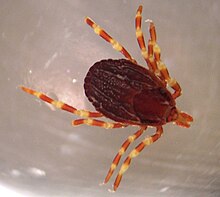
Back زجاجي العين Arabic زجاجى العين ARZ Hyalomma CEB Hyalomma German Hyalomma Spanish Hyalomma French Hyalomma Dutch Hyalomma Polish Hyalomma Portuguese Hyalomma Russian
| Hyalomma | |
|---|---|

| |
| Hyalomma marginatum specimen in alcohol | |
| Scientific classification | |
| Domain: | Eukaryota |
| Kingdom: | Animalia |
| Phylum: | Arthropoda |
| Subphylum: | Chelicerata |
| Class: | Arachnida |
| Order: | Ixodida |
| Family: | Ixodidae |
| Subfamily: | Hyalomminae |
| Genus: | Hyalomma Koch, 1844 |
| Species | |
|
See text | |
Hyalomma is a genus of hard-bodied ticks common in Asia, Europe, and North Africa. They are also found in Southern Africa. The name is derived from Greek: Hyalos (ὕαλος) crystal, glass; and omma (oμμα) eye.
The genus is believed to have originated in Iran or Central Asia, and then spread further into Asia, including the Middle East, and to southern Europe and Africa.[1]
Hyalomma are larger in size and do not have protective shields (indistinct festoons), but have eyes and banded legs. Hyalomma species are difficult to identify due to their hybridization and genetic and morphological variations, caused by harsh environmental conditions and lack of food sources. Hyalomma species are the only ticks to live in such harsh desert conditions. With few hosts available, they are required to be active as soon as a potential host is sensed.
Adult Hyalomma can bite humans and transmit serious pathogens. Immature (nymph) Hyalomma usually feed on birds, rodents, and hares and can be the cause of viral disease and rickettsias. Nymphs are often transmitted from one place to another by migrating birds. For example, a migrating bird carrying a Hyalomma marginatum nymph can cause Crimean-Congo hemorrhagic fever.[1] Hyalomma species can also transmit rickettsias like Siberian tick typhus, Boutonneuse fever, and Q-fever.[1]